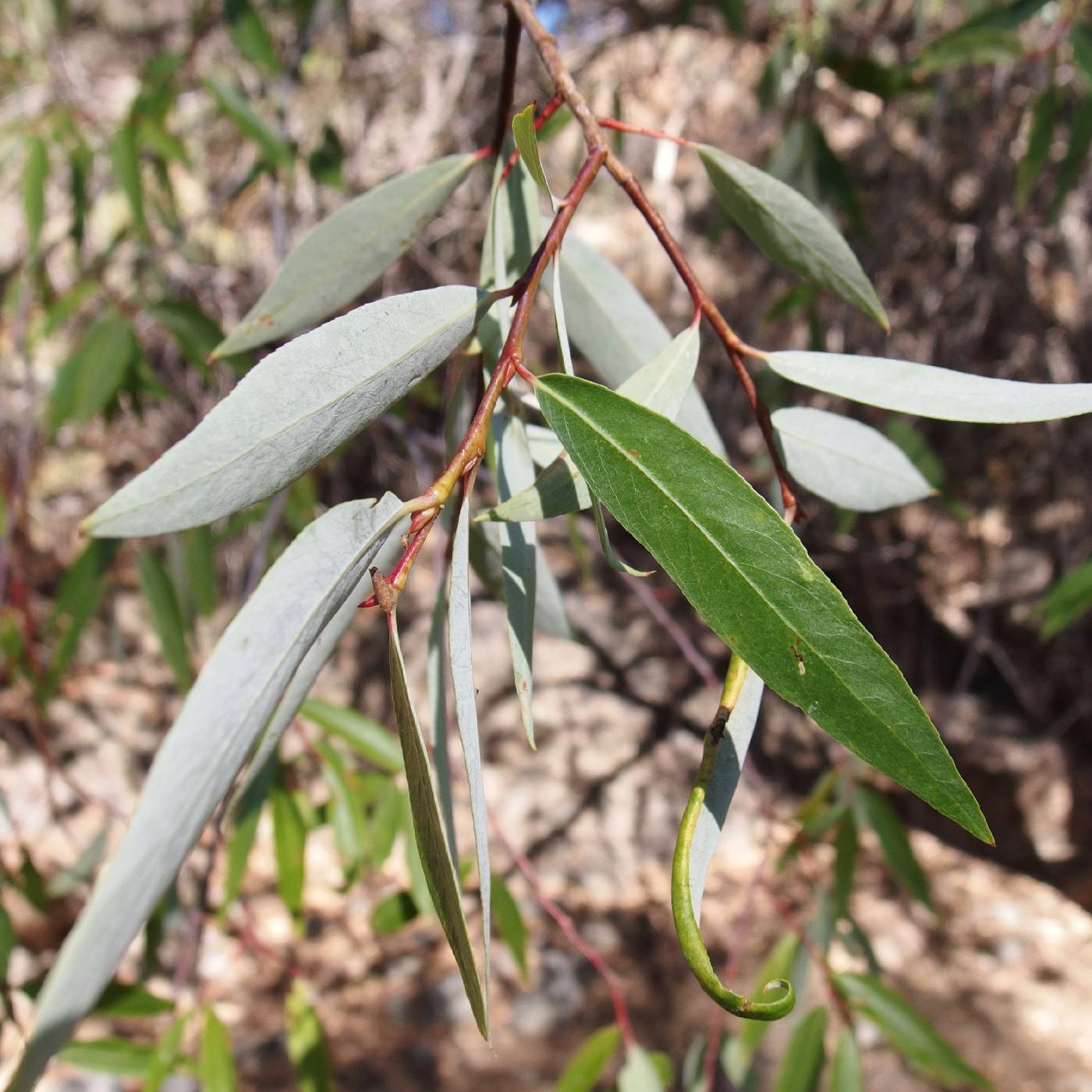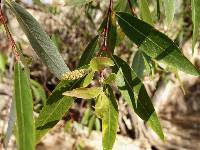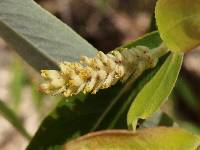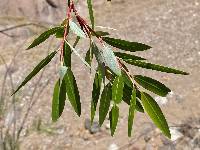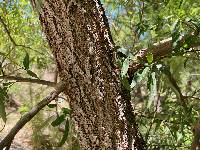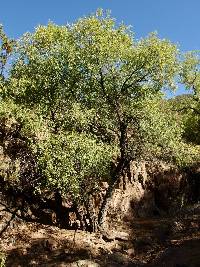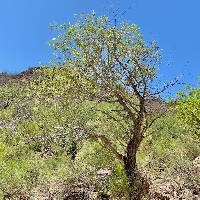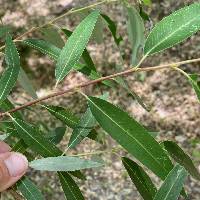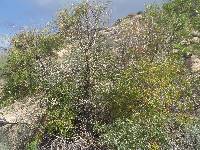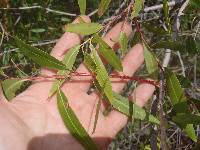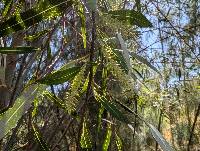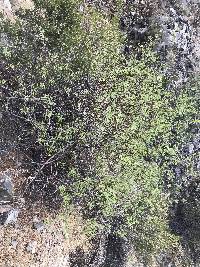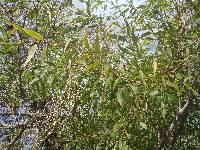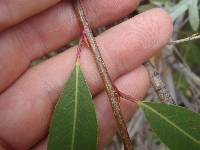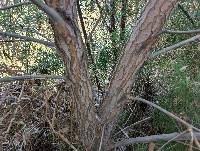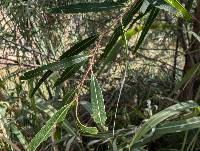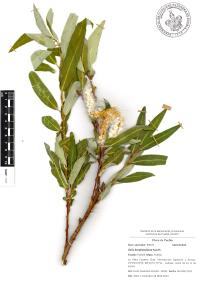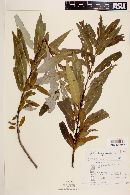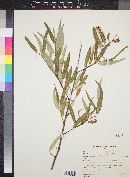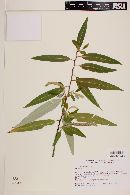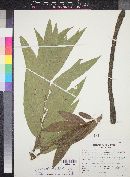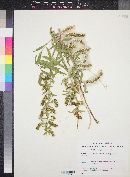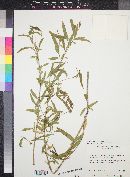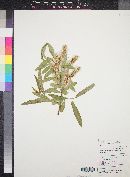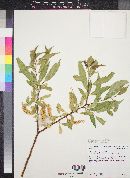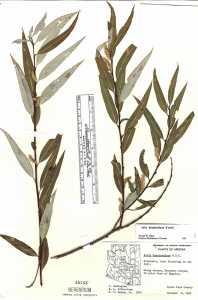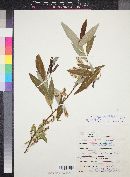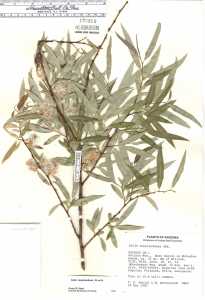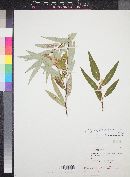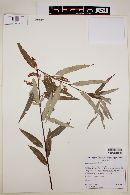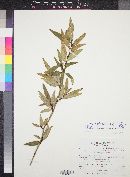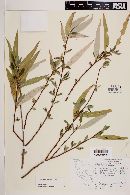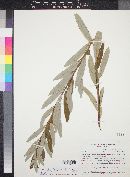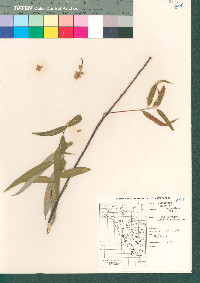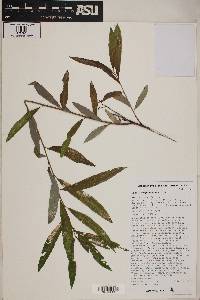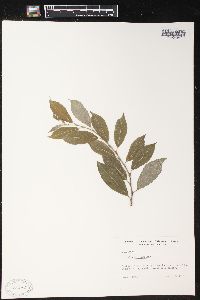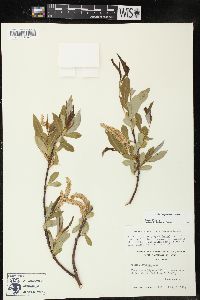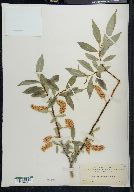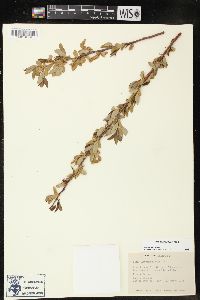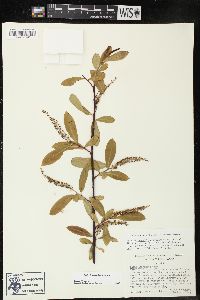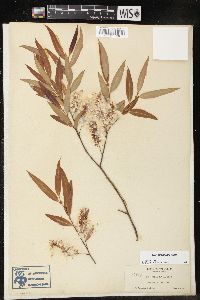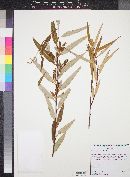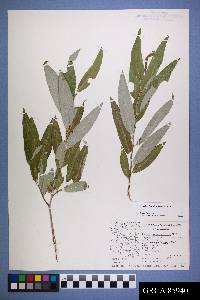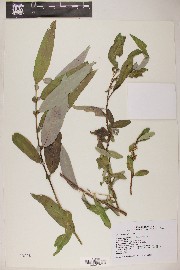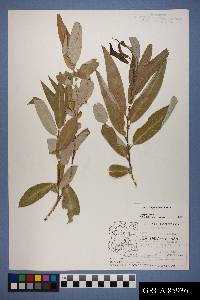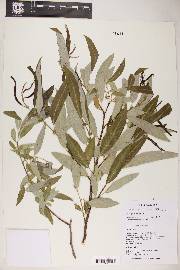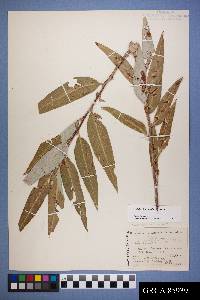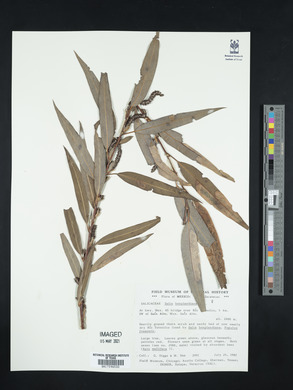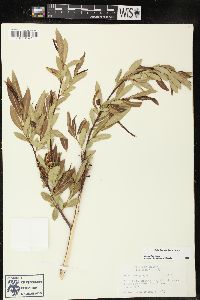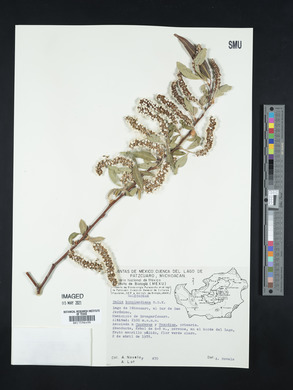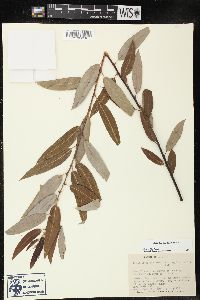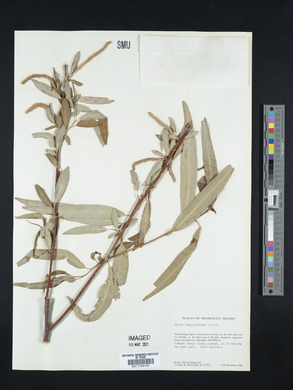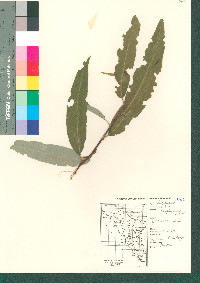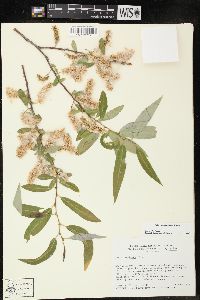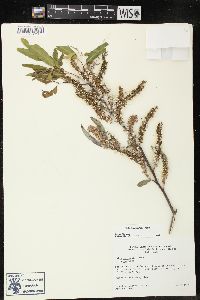Salix bonplandiana
|
|
|
|
Family: Salicaceae
Bonpland willow, more...Red Willow (es: sauce, sauz)
[Salix bonplandiana var. bonplandiana, moreSalix bonplandiana var. toumeyi (Britt. & Shafer) Schneid., Salix toumeyi Britt. & Shafer] |
Trees, 1-13 m. Stems: branches yellow-brown to red-brown, glabrous; branchlets yellowish, streaked with red or red-brown, glabrous or puberulent, nodes hairy. Leaves: (marcescent), stipules absent or rudimentary on early ones, foliaceous on late ones, apex rounded, convex, or acute; petiole (rarely with spherical glands distally), 4-16 mm, puberulent or pubescent to glabrescent adaxially; largest medial blade lorate to narrowly lanceolate, 58-155 × 7-27 mm, 4.5-10.7 times as long as wide, base cuneate to convex, margins serrulate to crenulate or entire, apex acuminate to acute, abaxial surface glabrous or glabrescent, hairs appressed, adaxial dull or slightly glossy, glabrous or pilose; proximal blade margins entire; juvenile blade glabrous, puberulent, pilose, or sparsely long-silky abaxially, hairs white. Catkins: (usually flowering throughout season and axillary, sessile), staminate 24-131 × 3-10 mm, flowering branchlet 0-12 mm; pistillate (densely to loosely flowered), 24-47 × 6-12 mm, flowering branchlet 0-10 mm; floral bract 0.6-2.2 mm, apex rounded to convex, irregularly toothed or entire, abaxially sparsely to moderately densely hairy proximally, hairs irregularly curly; pistillate bract persistent after flowering. Staminate flowers: abaxial nectary 0.2-0.6 mm, adaxial nectary oblong, square, or ovate, 0.2-0.6 mm, nectaries distinct or connate and cup-shaped; stamens 3-7; filaments hairy basally; anthers 0.3-0.5 mm. Pistillate flowers: adaxial nectary square to oblong, 0.3-0.6 mm; stipe 0.4-2.4 mm; ovary pyriform to obturbinate, beak slightly bulged below or tapering to styles; ovules 8-18 per ovary; styles 0.2-0.3 mm; stigmas (sometimes slenderly cylindrical), 0.18-0.27-0.32 mm. Capsules 3-6 mm. 2n = 38. Flowering Feb-Apr and throughout year. Riparian forests, along streams, dry washes; 700-2000 m; Ariz.; Mexico (Baja California, Chiapas, Chihuahua, Distrito Federal, Durango, Guanajuato, Guerrero, Hidalgo, Jalisco, Michoacán, Morelos, Nuevo León, Oaxaca, Puebla, Querétaro, Sonora, Tlaxcala, Veracruz, Zacatecas); Central America (Guatemala). Salix bonplandiana and S. laevigata are closely related and are sometimes treated as varieties (R. D. Dorn 1994). Their ranges overlap in Arizona and in northern Baja California, Mexico.
Plant: tree; to 13 m tall; stems branches yellow- to red-brown, glabrous; branchlets yellow-brown or tawny streaked with red, glabrous to pilose, tomentose at nodes; budscale margins free and overlapping Leaves: stipules rudimentary or absent; petioles pilose, 4-16 mm long; young leaves glabrous or puberulent; mature blade very narrowly elliptic to lanceolate, 58-155 mm long, 7-27 mm wide, 4.6-10.7 times as long as wide, the lower surface glaucous, the upper surface dull or shiny, glabrous or becoming so, the base acute, cuneate to obtuse; margins flat, serrulate, serrulate-crenate, or gland-dotted, with 6-12 teeth or glands per cm, the apex acuminate to acute INFLORESCENCE: coetaneous to serotinous; catkins typically borne in axils of leaves; floral bracts tawny, 0.6-2.2 mm long, with wavy hairs, the apices rounded; pistillate floral bracts deciduous after flowering Flowers: STAMINATE FLOWERS in moderately to densely flowered catkins 12-50 mm long; flowering branchlets 0-16 mm long; stamens 4-7; filaments hairy at base; nectaries 1 abaxial and 1 adaxial, broad to ovate, 0.2-0.6 mm long. PISTILLATE FLOWERS in loosely flowered catkins 15-53 mm long; flowering branchlets 2.5-11 mm long; ovaries glabrous; stigmas 0.2-0.3 mm long; styles 0.2-0.24 mm long; stipes 0.8-2.4 mm long; nectary broad to half-cup-shaped, 0.3-0.6 mm long, shorter than the stipe Fruit: lanceolate or ovate Misc: Forests along streams and dry washes; 750-1900 m (2400-5800 ft); Mar-Jun and throughout the year REFERENCES: Argus, George W. 1995. SalicaceaePart 2. Salix. J. Ariz. - Nev. Acad. Sci. 29(1): 39 Argus 1995 Common Name: Bonpland willow Duration: Perennial Nativity: Native Lifeform: Tree Wetland Status: FACW General: Trees to 13 m tall, with branches yellow to red-brown, glabrous, while branchlets are yellow-brown or tawny streaked with red, glabrous to pilose, tomentose at nodes. Leaves: Stipules rudimentary or absent, pilose petioles, 4-16 mm long, young leaves glabrous or puberulent, mature blade very narrowly elliptic to lanceolate, 58-155 mm long, 7-27 mm wide, 4.6-10.7 times as long as wide, lower surface glaucous, upper surface dull or shiny; base acute, cuneate to obtuse; margins flat, serrulate, serrulate-crenate, with 6-12 teeth or glands per cm, apex acute. Flowers: Catkins borne in axils of leaves, tawny floral bracts, 0.6-2.2 mm long, with wavy hairs, apices rounded; pistillate floral bracts deciduous after flowering; staminate moderately to densely flowered, while pistillate flowers loosely so. Fruits: Lanceolate or ovate capsule. Ecology: Found in forests along streams and dry washes from 2,500-6,000 ft (762-1829 m); flowers March-June. Notes: Distinguished by the catkins being borne in the axils, the petioles are also pilose at the base, and the leaf blades 4-12 times as long as wide. Ethnobotany: Bark used for fevers, infusion of the roots taken for diarrhea, used in basketry, for fuel and building materials, for cradles, posts, sweathouses, arrows and bows, mats, whistles, and as a protective charm. Etymology: Salix is the Latin name for willow, meaning -to leap or spring-, while bonplandiana is named for Aime Bonpland (1773-1858) a French botanist. Synonyms: Salix bonplandiana var. toumeyi, Salix toumeyi Editor: SBuckley, 2010 |
|
|
|

